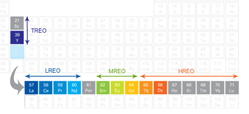The Britholite Mineral
Although the rare mineral britholite (comprised of a consistent chemical combination of the elements calcium, yttrium, iron; as well as a couple of chemical compounds of phosphates and silicates) is most commonly found in the central-eastern parts of modern day Russia, the first human discovery of it was first recorded in a district of South Greenland. It can also be found in sizable portions in Canada, Argentine, the Urals and South Africa; and usually forms as a result of substance variations in a very hot water underground, precipitating out of the mixture as lustrous brown crystals. Of course, because one of the unique aspects of britholite is the interchangeability of its chemical structure, which means that certain elements can be exchanged for others – some of the more common atoms and molecules are cerium and sodium – it can also assume a muted green color or no color at all; appearing translucent.
The chemistry of britholite has academic importance in the field of mineralogy, where it can often be substituted for applications that use the rare element neodymium. Much work has been done on discerning particular aspects of the chemistry of britholite, using techniques ranging from bulk analysis with coulometric titimetry, a very technical procedure that causes a reaction between water and the element iodine; britholite is placed in this solution and heated continuously for several days at a moderate temperature, in order to boil the water off and then analyze the resulting crystal structure of the sample. Afterwards, a powerful camera is employed to take long exposures of a slowly spinning sample of the dried britholite, which apparently helps chemists determine the atomic spacing.
Because britholite is found in several places all over the world, and has different characteristics (most notably color) depending on the hydrothermal characteristics of the region, some of the chemical values will change, and it is important to state the region from which a tested sample has been gathered. In particular, britholite from the Eden Lake Complex in Canada can be a bright yellow-orange hue (in plane polarized light), with an obvious granular structure under close inspection. These intermittently dark orange grains form a polygonal structure and criss-crossing terrain that rather resembles old NASA photos of what was believed to be ancient Martian canals. The mineral is closely associated with; and often comes embedded with, minerals ranging from allanite (a mineral of aluminum), titanite (the mineral form of the element titanium, which as hard as steel but only 40% as heavy), a potassium-laced version of the mineral feldspar, quartz and a brilliant mineral of gold (aegirine-augite).
Finding completely pure versions of britholite is impossible in nature; it simple has too many mineral cousins. Chemical analysis often reveals one of the closer cousins, apatite, and interspersed deep within the junctions of britholite’s atomic structure at regular intervals, in a very stable arrangement. In a chemical-mineral sense; they like to be together, and have an outer electron structure that interlocks readily.
The above pedestrian chemicals are not the only ones often included in britholite’s structure; nuclear elements Uranium and Thorium are also found in trace amounts. It actually appears that the hydrothermal fluids that dominate the environment where britholite is formed – at least at the Eden Lake Complex in Canada – alters the structure in ways significant enough to change the chemistry a bit, depending on whether or not the fluids moved along the boundaries. In retrospect, this probably isn’t so strange, because the great temperatures would likely cause chemical reactions to progress in different directions. Some of the effects can be removal of any Cerium, Lanthanum or fluorine, and replacement with an even more electronegative ion of fluorine, a hydroxide group with a vigorous appetite for protons, and an atom of chlorine that also wants a positive charge. How much the hot fluid affects it depends on the preexisting state of stability; if it is already in a state of chemical flux, then the changes will be more significant.
In sum, britholite from the Eden Lake Complex in Canada differs from that in other regions because of the particular elements in the hydrothermal fluids in that region, such as phosphorus and fluorine, which affects its structure when an unstable crystal is washed along granular fractures and zones where it’s already cracked. A chemical reaction ensues, which then crystallizes the britholite and anneals it due to the heat. Further chemical alterations brought ions of hydroxide to displace fluorine ions, leading to the final form known as altered britholite.

